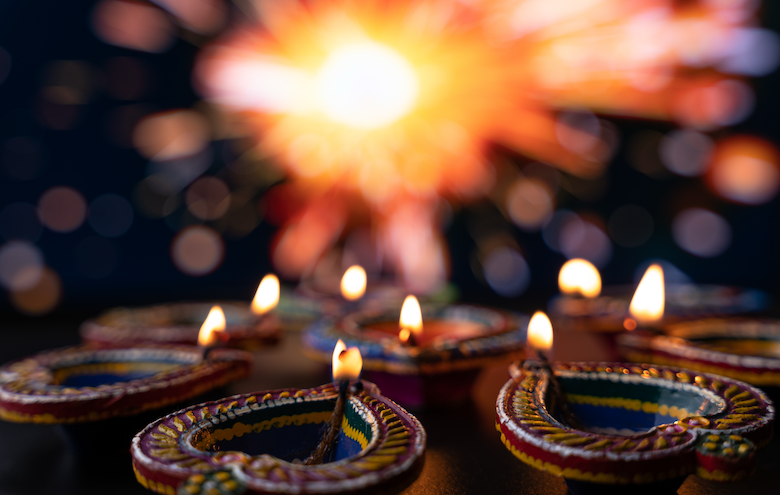
Diwali 2025 - discover the origins and science behind the light
Diwali, known as the ‘Festival of Lights’, is one of the most celebrated festivals in the world.
It’s filled with vibrant traditions, dazzling lights, and joyous get-togethers.
Etymology of Diwali
The word ‘Diwali’ is derived from the Sanskrit words “dīpa” and “āvali”.
As explained by Head of English, Louis Provis in this video on the etymology of ‘Diwali’, the literal translation is “dīpa” = “lamp” or “light”, and “āvali” = “row” or “series” - essentially ‘a series of lights’.
More metaphorically, this represents the triumph of ‘light’ over ‘dark’, ‘good’ over ‘evil’ or ‘knowledge’ over ‘ignorance’. It's for this idea of light overpowering darkness that Diwali is celebrated alongside a new moon, so the date changes every year. The festival lasts five days, with each day having its own meaning. In 2025, Diwali runs from 18 October to 23 October.
The origins of Diwali
The roots of Diwali can be traced back to ancient India and is commonly associated with Hinduism, with stories and practices surrounding the festival stretching back thousands of years.
Today, the cultural and spiritual significance of Diwali spans multiple regions and religions, holding special meaning in Sikhism, Jainism, and Buddhism. Diwali is a national holiday in 11 countries, including Fiji, Malaysia, and Nepal. In the UK, the Midlands city of Leicester hosts one of the biggest Diwali celebrations outside of India, drawing tens of thousands to celebrate with fireworks, diyas, and cultural performances. The UK’s House of Commons also marks the festival, showing its significance in modern British culture.
Hinduism provides the most famous origin of Diwali coming from the Ramayana, composed in the 5th century BCE. In this ancient Indian epic, Lord Rama is victorious over Ravana and returns to Ayodhya - the city in Uttar Pradesh considered his birthplace - after 14 years in exile. Upon arriving, people illuminated ‘diyas’ to symbolise the triumph of light over darkness. Ayodhya remains an important pilgrimage site.
Sikhs know Diwali as ‘Bandi Chhor Divas’, which symbolises the triumph of freedom and justice over oppression, celebrating the release of the sixth Sikh Guru, Hargobind Singh and 52 princes from prison.
In some Buddhist communities Diwali honours Emperor Ashoka’s conversion to Buddhism. Ashoka is said to have converted after witnessing the devastation his own conquests - in particular the Kalinga War - caused, and celebrates the renunciation of violence and war in favour of peace.
Meanwhile in Jainism the enlightenment of Lord Mahavira is celebrated during Diwali. Lord Mahavira was the 24th Tithankara of Jainism and his attainment of ‘moksha’ (meaning ‘liberation’) is marked by the lighting of lamps.
Evolution of Diwali traditions
Throughout the millennia Diwali has been celebrated, the festival’s close ties to religion have grown into a colourful celebration blending tradition with modern customs.
While the core message of light overpowering darkness remains, over the centuries new rituals have added to the spectacle, including:
Lighting diyas
Oil lamps, or diyas, have been a Diwali tradition for centuries. As mentioned above, they originally symbolised Lord Rama’s return in Hindu culture.
In the present day, they more broadly represent the victory of good over evil by filling homes and streets with a warm glow. It’s possible to make these at home with wheat flour, water, colourful paint, and a little dash of creativity.
Sharing sweets
Exchanging sweets during Diwali is one of the ways people spread joy and goodwill. Families now gift trays of mithai, like laddus and barfis, as a symbol of gratitude and happiness. Some other common sweets include halwa, peda, galub jamun, and jalebi - all of which can be found in many UK shops or online.
Fireworks
While fireworks are a recent tradition, they’ve become an essential part of Diwali, symbolising and celebrating the triumph of light. They’re also believed to ward off spirits.
The reason fireworks are a new addition to Diwali is that the festival predates the invention of even natural firecrackers made from Bamboo. The first use of fireworks in India dates to roughly 1,400 AD after gunpowder was first introduced to the country.
The science behind fireworks is interesting and combines lessons from both Chemistry and Physics.
A typical firework consists of a shell, a lift charge, and a burst charge. The shell is filled with small pellets called ‘stars’, with each containing a bespoke chemical mixture.
When the lift charge is ignited, it rapidly burns, producing a large volume of hot gases. This creates high pressure inside the shell, propelling it upwards according to Newton's third law of motion: for every action, there is an equal and opposite reaction.
Once the lift charge propels the shell into the air, the burst charge ignites the stars inside the shell and creates the dazzling display fireworks are known to produce.
The brilliant colours seen in fireworks are produced by specific metal-containing salts. When these salts are heated, their electrons become excited and jump to higher energy levels. As the electrons return to their original state, they release energy in the form of light. The colour of the light depends on the specific metal present.
Shubh Deepavali
Diwali brings people joy and renewal worldwide.
So, whether you’re lighting a diya, sharing sweets, or enjoying fireworks, “Shubh Deepavali” (Have an auspicious Diwali).